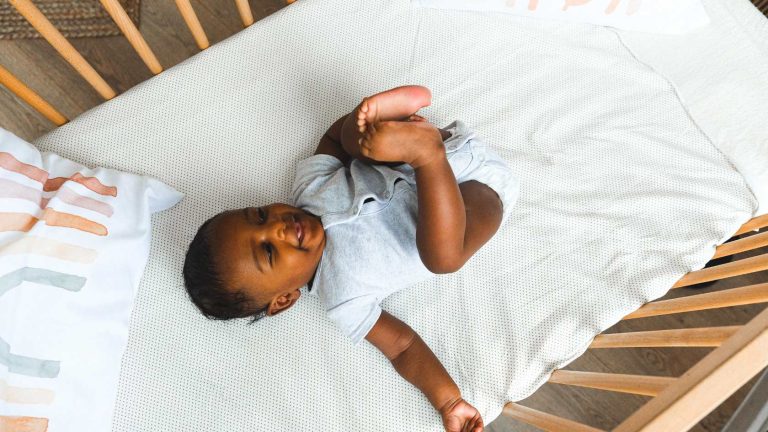
Top 6 Crib Alternatives for Your Baby: Advantages and Disadvantages
- Created:
16. 2. 2023 - Updated:
18. 10. 2023
Listen up!
Is your home low on space? Are you curious about effective and safe substitute sleeping arrangements? Or are baby crib prices just downright outrageous?
Fortunately:
I’ve got something for everyone here.
So, say goodbye to traditional baby cribs as you explore the six best crib alternatives for your infant.
1. Co-Sleeping or Bed-Sharing
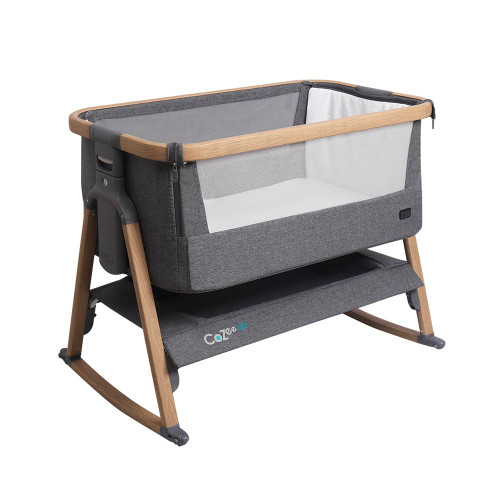
Get this:
There is some dispute on the actual meaning of co-sleeping. Does it necessarily mean bed-sharing, or could it possibly connote room-sharing?
The thing is:
Both bed-sharing and room-sharing are forms of co-sleeping.
However, I will focus on bed-sharing specifically.
You see:
Bed-sharing involves a caregiver or parent sleeping in an adult bed with an infant. And it is one of the most common and controversial alternatives to using a crib.
To corroborate this claim:
A study by the National Institutes of Health (NIH) covering 1993 to 2010 proved that the bed-sharing rate doubled from 6.5 percent to 13.5 percent.
So, what makes bed-sharing so popular?
Now:
Aside from the fact that you entirely bypass purchasing a crib, thereby saving money, it has several attractive benefits.
Here are some advantages of bed-sharing:
- Bed-sharing leads to more frequent and consistent breastfeeding at night as mothers and babies have improved access to each other. In fact, JAMA Pediatrics discovered that babies who shared a bed with their mothers had a higher frequency and lengthier duration of breastfeeding.
- Because the mother does not have to get up continuously through the night to breastfeed, nurse, or pacify their baby, sleep is relatively improved. Some parents even sleep more comfortably, knowing their baby is just within reach.
- Experts have suggested that bed-sharing promotes bonding between parents and their babies. Babies typically crave being held most of the time, and such physical connection is vital for satisfying your baby’s psychological needs, including comfort and security.
Unfortunately, the risks and disadvantages involved with bed-sharing far outweigh the benefits.
Here’s the thing:
- Bed-sharing raises the risk of sleep-related infant deaths such as suffocation or Sudden Infant Death Syndrome (SIDS). For this reason, the American Academy of Pediatrics (AAP) recommends against bed-sharing, though room-sharing is acceptable and even encouraged.
- The risks increase exponentially if a parent is intoxicated with alcohol, tired, or under the influence of hard drugs. Or if instead of a bed, you bed-share on a sofa or couch.
- Your child might become too attached to your bed as it grows and may eventually refuse to sleep in its own bed.
- You may have to synchronize your routine and habits around your child’s bedtime.
As you know:
Bed-sharing with an infant in an adult bed could pose life-threatening or fatal outcomes.
Regardless, parents who engage in this practice for its benefits should employ specific safety measures to protect their babies.
Try these preventive measures:
- Remove all excess pillows, heavy bed covers, toys, or stuffed animals from the bed. Doing this would reduce the risk of suffocation or entrapment of your baby.
- Ensure the bed is adequately sized for bed-sharing between a caregiver and an infant. You would need a large bed with enough room to lower the chances of your baby falling off or you rolling over it.
- Use a snuggle nest to barricade your infant. This creates a comfortable space around it, preventing it from rolling off the bed.
- Completely diminish your alcohol and drug intake and avoid smoking. You cannot afford to be intoxicated while sharing a bed with your child. The consequences are incredibly costly and potentially fatal.
- Ensure the room is at an optimal temperature. Hot and stuffy rooms will cause your baby to overheat, leading to an increased sleep safety risk. Also, make sure the room is free from toxic fumes before bedtime.
At the end of the day:
The decision to bed-share is up to you!
In any case:
Consult an experienced pediatrician to understand the full scope of the hazards and the practice of safe bed-sharing or co-sleeping.
2. Snuggle Nest or Baby Nests
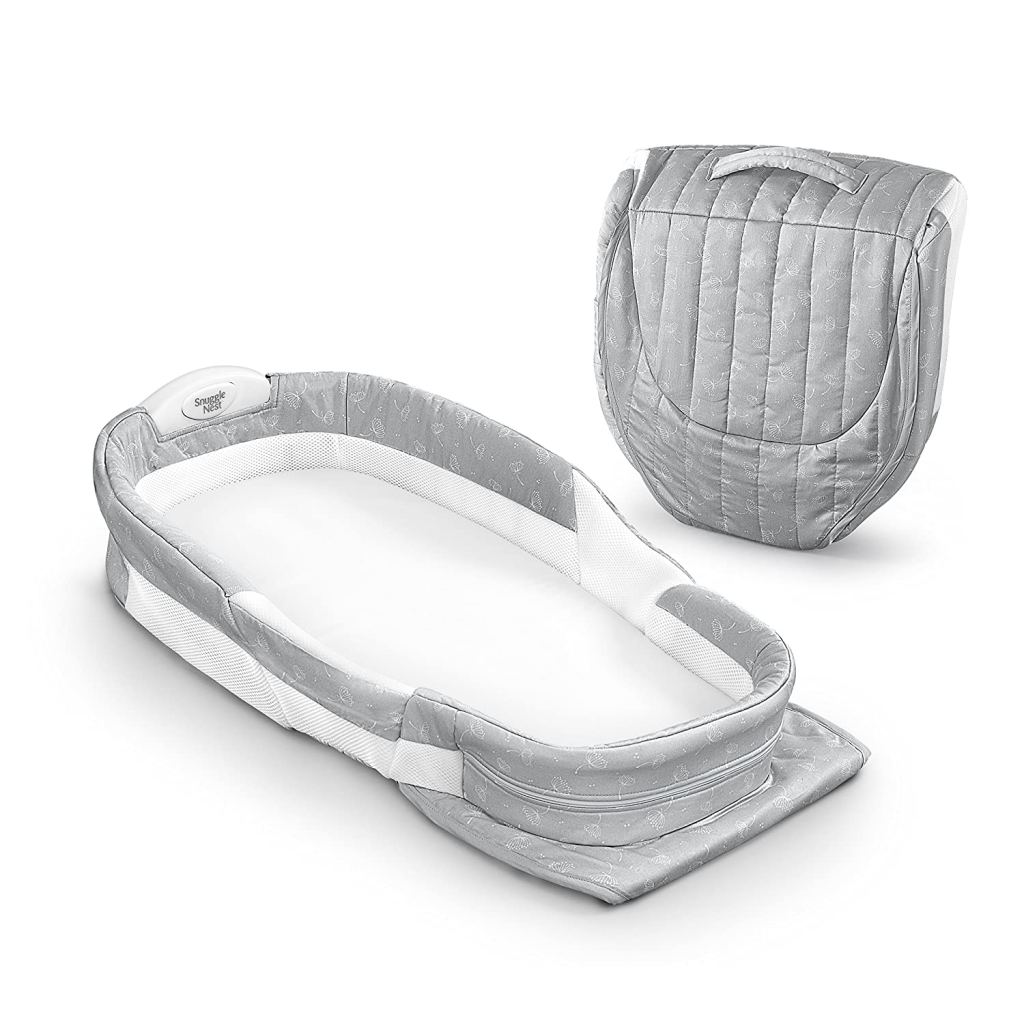
Now:
Often called a baby lounger or nest, another affordable crib alternative to try is a snuggle nest.
It is a portable baby bed with a comfortable but firm foam base and a breathable cushion border surrounding it.
You might want to opt for a snuggle nest for these reasons:
- It keeps the baby in place on the bed and prevents it from rolling off the bed.
- The structure of the snuggle nest creates the illusion of a mother’s womb. Thus, providing your baby with a sense of comfort and familiarity.
- The limited space in the nest prevents your infant from flipping over on its belly.
- It affords caregivers some flexibility due to its portable nature.
However:
Although these advantages are quite convincing, a few factors might put you off the idea.
Here’s the thing:
- The snuggle nest has no safety regulations or standards from any authoritative body. As such, their safety is unverifiable.
- Your baby is at risk of suffocation if you use a snuggle nest manufactured with soft sides and a feeble foam base.
- It can only be used for a short time, as your baby will eventually outgrow the cushion frame.
Note:
To guard against purchasing an inferior product, I advise you to select a snuggle nest made with Oeko-Tex standard 100-certified textile material.
It is a world-renowned brand tested for harmful substances, so you’re confident of getting the safest product for your baby.
3. Play Yard or Pack n’ Play
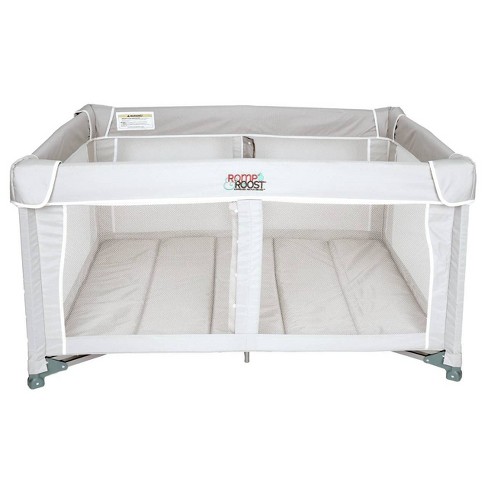
Fact:
A play yard is a portable enclosure surrounded by mesh or fabric side walls intended to protect a sleeping or playing child.
It is reasonably similar to a travel crib, though larger. However, both are interchangeable, and their functions can be shared.
Here’s why you should use a play yard instead of a classic baby crib:
- The Consumer Product Safety Commission (CPSC) strictly regulates play yards to fit specific safety standards. As a result, it is one of the safest crib substitutes for your baby.
- It is guaranteed to serve you longer than any other crib alternative. You can use a sturdy play yard until your baby is up to three years old.
- It is incredibly convenient and gives your baby a safe space to sleep and play even while you’re on the go.
Listen:
Regardless of its numerous benefits, the play yard, like other alternatives, still has some controversy surrounding it.
The central argument against this substitute is that it could impair your baby’s emotional and mental development. This is due to isolation and restriction.
However:
This only applies to babies left in the play yard for extended periods.
If you use the play yard only when it needs to be used, your baby should be unaffected by these issues.
4. Bassinet
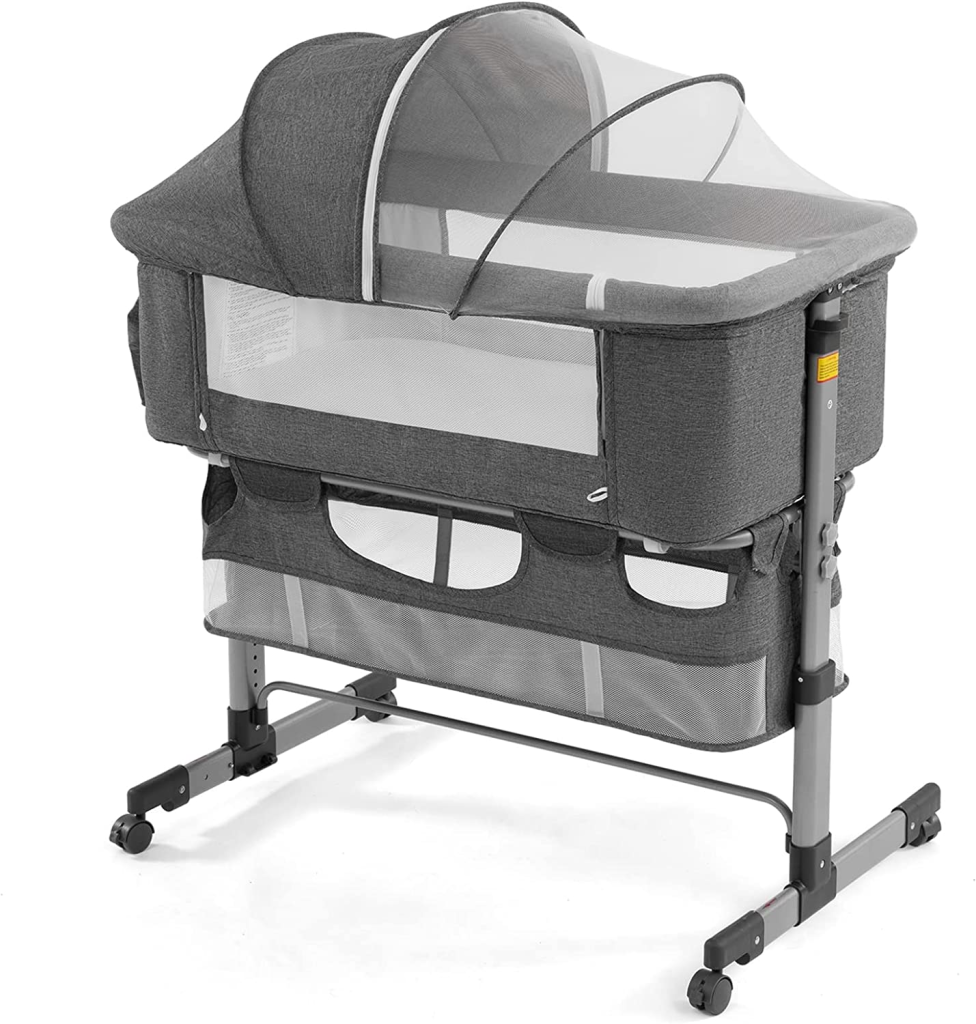
So:
The bassinet is another standard sleeping arrangement used in place of a crib.
It is specifically designed to accommodate newborns, which is why it is significantly smaller than a crib.
You see:
The AAP mentions the bassinet among other safe crib alternatives in its recommendations for safe sleep for babies.
This recommendation classifies it among the safest crib substitute options for your baby.
Furthermore:
You can even opt for a Moses basket, a more traditional bassinet made with wood and wicker or wool.
Some people prefer this bassinet type for purely aesthetic reasons; apparently, watching your baby sleep in a wicker cradle is heart-melting.
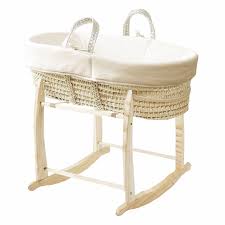
In any case:
I think you should use a bassinet for these reasons:
- Most bassinets, like bedside sleepers, are attached to the bedside for convenient access to your baby during the night. This supports the practice of room-sharing without bed-sharing in line with the AAP recommendation.
- Bassinets are compact with a small footprint and would sit snugly in any given space.
- Many bassinets are mobile and portable, so your baby can take naps close to you in the daytime. This affords the caretaker some levels of flexibility.
- Bassinets make the motions of picking your baby up and putting it down a lot more comfortable compared to a crib.
- The bassinet’s low sides allow you to handle your baby without much strain and practically eliminate the need to bend over.
Notwithstanding:
Here are some factors that might discourage you from selecting a bassinet as a crib alternative:
- Your baby will grow out of the bassinet in about six months. As such, you may have to purchase the crib you were trying to avoid. Plus, the bassinet has weight limits.
- Although a bassinet costs way less than a crib, it is still one of the more expensive alternatives. So, if you’re currently running low on funds, this might not be the perfect fit for you.
One more thing:
Your baby may refuse to sleep in the bassinet for a plethora of reasons.
Consequently, switching to another more comfortable crib alternative might be the best course of action.
5. Hammock
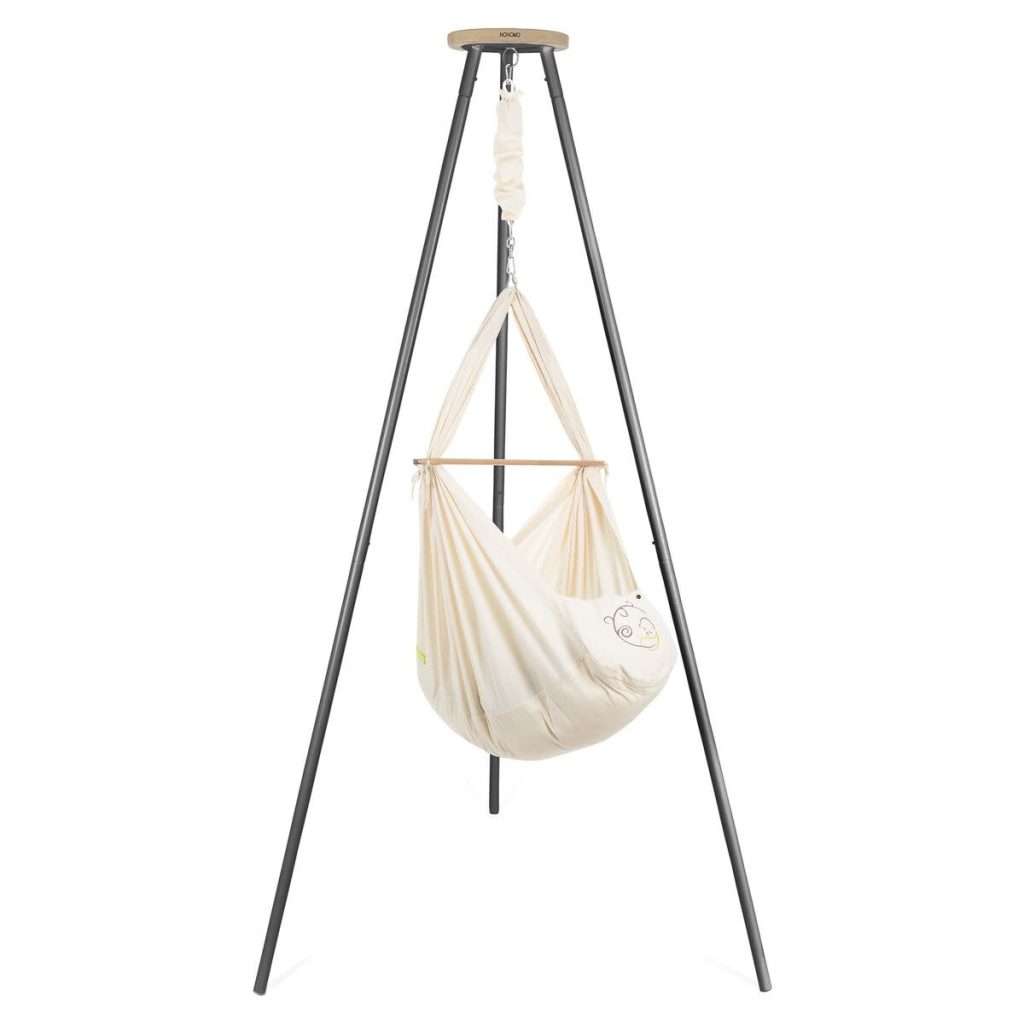
Believe it or not:
Though not the most conventional sleeping arrangement for a baby, the hammock is effective and popular among parents and caregivers.
Designed to have a womb-like feel, it is made from cloth, cushioned with a firm foam base, and suspended from a beam.
Now:
The hammock comes with some appealing advantages.
- The main draw is that it acts as a baby swaddle, holding your infant snugly and giving it a sense of security and comfort.
- The rocking motion of the hammock is said to have soothing effects on your baby, pacifying it when necessary. It relieves you of that burden and provides much-needed peace of mind.
However:
In recent years, safety concerns have come up regarding the use of a hammock.
Here are some disadvantages that may likely dissuade you from selecting this sleeping option:
- Your baby could end up rolling to the side and pushing his face against the material. And if the material isn’t breathable enough, it could suffocate your infant.
- Unfortunately, the hammock has no distinct protective barrier. So, if your child is restless, it could fuss its way out of the hammock and tumble to the ground.
- Some hammocks have a flexible base that aligns your baby’s neck at an uncomfortable angle. This makes breathing barely possible or difficult.
- Over time, your baby may begin to depend on the rocking motion to sleep and find it hard to adjust to a stationary bed.
- Some fabrics used for the hammock might hinder air circulation and cause your baby to overheat.
Look:
By design, hammocks do not meet the safe sleep recommendation.
However, experts believe that if you take certain safety precautions, you can avoid the risks of using a hammock for your baby.
Keep the following tips in mind:
- First, ensure your baby is never left unsupervised while in the hammock.
- Healthcare professionals strongly advise that you lay your baby on its back while using the hammock or any other crib alternative. It is unsafe to place your baby on its side or front as it poses the risk of suffocation.
- Make sure the frame is sturdy, and the fabric is firm enough to hold your baby’s weight. The last thing you want is the hanging hammock to come crashing down while your baby is still entangled.
- In the same vein, check that the hammock is suspended securely from a well-balanced area. Ensure the fastenings are re-tightened frequently, as they could become loose over time due to friction.
- As an extra measure, you could place a firm mattress underneath the hammock for protection in the event of an accident.
- Pillows, blankets, or stuffed toys are an absolute NO for your baby’s hammock. These items could lead to suffocation or overheating.
- Ensure the fabric used for the hammock is breathable and easy to wash. You should go for a hammock made of soft linen or cotton.
All in all:
If you still have reservations, consulting a licensed medical practitioner should help you make the right decision for your baby.
6. Cardboard Box
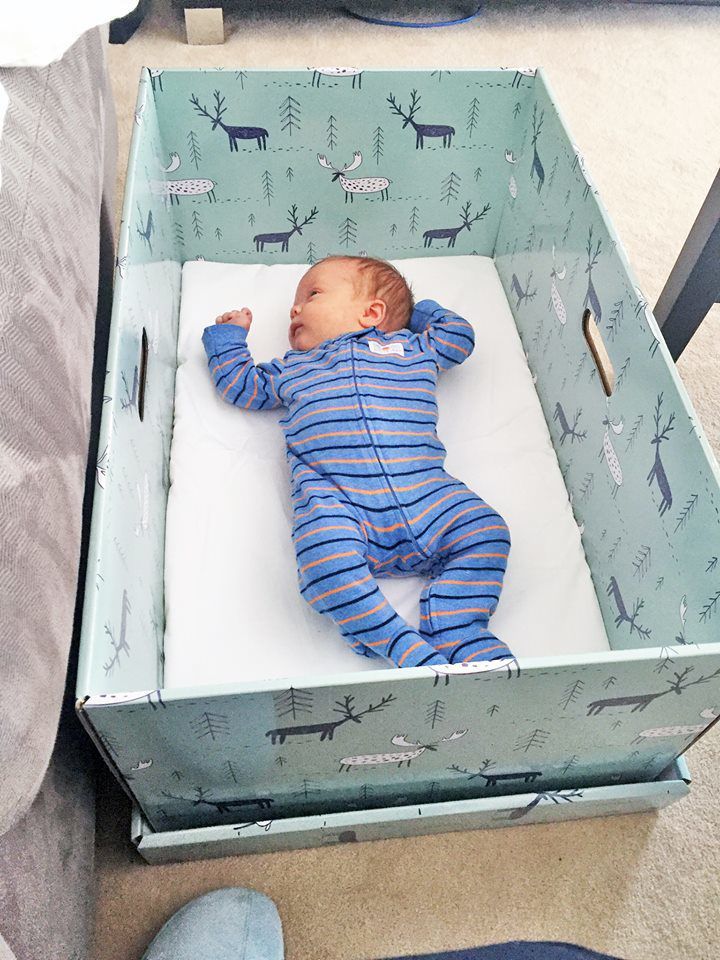
You’re probably wondering:
A cardboard box as a crib alternative? Really?
Why would anyone place their baby in a cardboard box?
You see:
While I agree that this specific crib alternative seems absurd at first, it’s actually a pretty common practice in certain countries, like Finland.
And for valid reasons too.
Get this:
It is the tradition in Finland for expectant mothers to receive a care package in a cardboard box with a mattress.
This box usually contains clothes, diapers, bed linens, and toys for the coming baby.
Then:
After the mother puts to bed, this cardboard box becomes the baby’s first sleeping arrangement.
As expected, many people have taken a cue from this culture and begun to use cardboard boxes as substitutes for cribs.
This could be attributed to these reasons:
- You need little to no money to get a suitable cardboard box for your baby.
- Some believe using the cardboard box as a crib has helped Finland achieve an incredibly low infant mortality rate. Do with that information what you will.
- Cardboard boxes are minimalistic and super portable.
- Cardboard boxes are recyclable and eco-friendly. Simply repurpose the box as soon as your baby has outgrown it. You can even use it as a storage unit for your baby’s items.
However:
Like other alternatives, the cardboard box comes with its downsides.
- You cannot be certain that the box is safe for your child as it could be produced with harmful materials. So, you’d want to opt for commercially produced baby boxes made with baby-safe materials.
- Your baby might find the cardboard walls quite uncomfortable compared to the cushioned walls of other crib alternatives.
- It is not a long-lasting sleeping arrangement, as your baby will outgrow the box with time.
- Cardboard boxes must be placed on the floor to avoid the risk of toppling your baby from an elevated surface.
- Even though you may have picked a durable box, contact with large amounts of water could compromise it. To that end, keeping your box far away from liquids would be wise.
Lastly:
Cardboard boxes do not conform to the general definition of a crib and have no mandatory safety standards attached to their usage.
As such, it would be best to choose a durable and firm cardboard box for your child’s safety.
Final Tip: Annie Baby Monitor – Your Super Supervision in Baby’s Sleep
As a parent, you want your baby to sleep soundly and safely, right?
That’s where Annie Baby Monitor comes in to save the day!
Place it in your baby’s room, and you can keep a watchful eye day or night. With real-time video and audio monitoring and motion and cry detection, you can be there for your baby even when you’re not physically in the room.
No more worries about your baby’s safety and well-being while you’re away. Annie Baby Monitor has got your back!
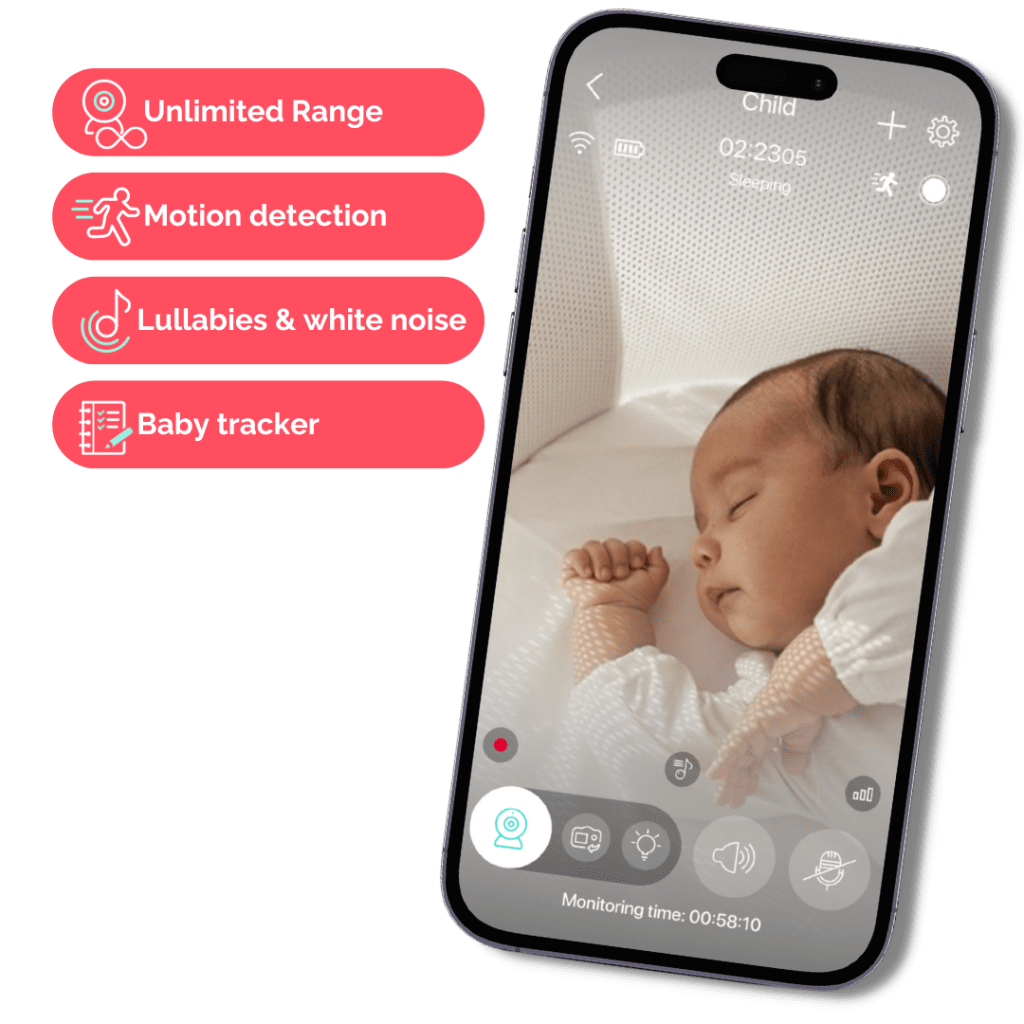
It’s the perfect solution for keeping tabs on your little one. Check it out now.
Conclusion
Ultimately:
We all want what’s best for our babies. We want them to sleep comfortably and safely in sturdy cribs.
However:
If traditional cribs don’t cut it for your home space or budget, you should give alternative sleeping arrangements a shot.
To that end, I’ve compiled some of the safest, most effective, and most cost-friendly options.
Try these out:
- Co-sleeping or bed-sharing
- Snuggle nest or baby nest
- Play yard or pack n’ play
- Moses basket
- Bassinet
- Hammock
- Cardboard box
Note that:
Most of these crib alternatives would not be useful for very long as your baby will outgrow them after about six months.
Notwithstanding:
They are worth that chance!
Don’t forget to leave a comment below! I’d love to know if you tried any of my recommendations.

Frequently Asked Questions About Crib Alternatives
There are multiple available substitutes for the classic baby crib. Besides the commonly used bassinet, Moses basket, play yard, and snuggle nest, you can also use a hammock or cushioned cardboard box.
While the AAP recommends using a crib for sleep safety, it also endorses the bassinet and play yard as suitable crib alternatives. In line with this, it is safe to say that cribs are not entirely necessary.
The Louisiana Department of Health posits three safe crib alternatives: a pack n’ play, a cardboard box, and a dresser drawer. If none are available and you are completely sober, you could try sharing your bed with your baby.
You can use a firm mattress placed on the floor instead of a crib; however, this is not the safest practice for an infant.






